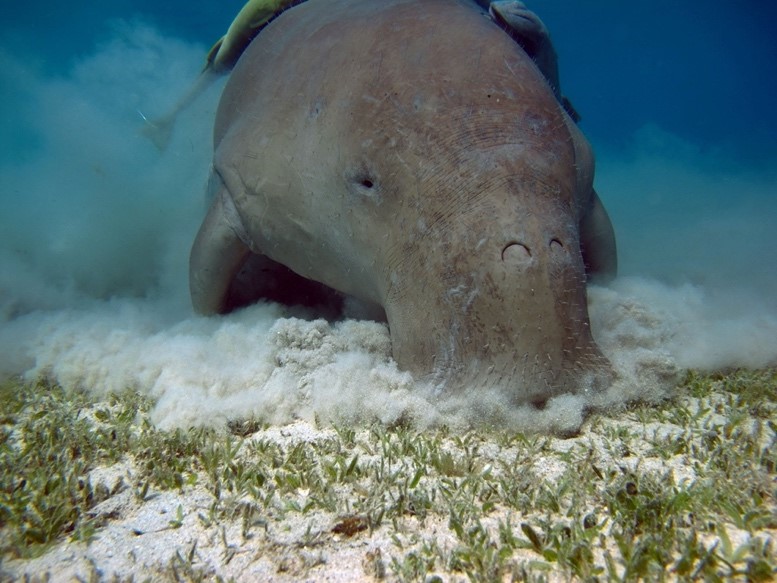Description
 Disclaimer: Copyright infringement not intended.
Disclaimer: Copyright infringement not intended.
Context
- A group of fishermen in the city of Thanjavur, Tamil Nadu rescued and released a young Dugong that had been caught accidentally in their fishing net.
About Dugong
Geographic Range
- Dugongs (Dugong dugon), also known as sea cows, have a broad but fragmented range, encompassing tropical waters from East Africa to Vanuatu.
- This range spans at least 48 countries and about 140,000 km of tropical coastline.
- The largest population of sea cows is found in the northern waters of Australia between Shark Bay (Western Australia) and Moreton Bay (Queensland).
- The second largest population is found in the Arabian Gulf.
- Dugongs are not considered migratory but are known to travel great distances within their range in order to find food.
.jpeg)
Habitat
- Unlike their mostly freshwater cousins, manatees, dugongs are primarily marine mammals.
- Dugongs generally inhabit shallow waters, remaining at depths of around 10 m, although they occasionally dive to depths of 39 m to feed.
- These shallow areas are typically located in protected bays, wide mangrove channels and in sheltered areas of inshore islands.
- Seagrass beds consisting of phanerogamous seagrasses, their primary source of nourishment, coincide with these optimal habitats.
- Habitat Regions: tropical saltwater or marine
- Aquatic Biomes: coastal
- Other Habitat Features: estuarine
|
Physical Description
- Dugongs are large, solid mammals with short, paddle-like front flippers and a tail with a straight or concave perimeter that is used as a propeller.
- Their tail differentiates them from manatees, the tail of which is paddle-shaped.
- Dugong fins resemble those of dolphins, but unlike dolphins, dugongs lack a dorsal fin.
Behaviour
- Dugongs are a very social species and are found in groups varying from 2 to 200 individuals.
- Dugongs are a semi-nomadic species.
- Because dugongs are usually found in turbid water, they are difficult to observe without disturbing them.
Food Habits
- Dugongs are primary consumers and the only completely herbivorous marine mammals.
- When seagrass is scarce, dugongs also eat marine algae.
- They are speculated to supplement their diet with invertebrates such as polychaete worms, shellfish and sea squirts which live in seagrasses.
Ecosystem Roles
- Intensive grazing of dugongs on seagrass has numerous effects on the ecosystem, both directly on the seagrass and indirectly on other organisms that live in or feed on seagrass.
- Their grazing contributes to nutrient cycling and energy flow as they stir up sediment.
- Their fecal matter also acts as a fertilizer, which helps seagrass to more quickly reestablish.
- Dugongs are economically valuable while alive as a form of ecotourism.
Uses
- Humans eat their meat and use their oil.
- Dugong tusks are also used as a treatment for a variety of ailments including asthma, back pain, and shock.
- Tusks are also made into amulets and, in powdered form, mixed to make a drink.

Conservation Status
- Dugongs are listed as a vulnerable on the IUCN Red List and is on Appendix I on CITES.
- This threatened status is primarily due to human hunting and activities.
- Dugongs are inadvertently trapped in fish and shark nets and die due to lack of oxygen.
- They also get struck by boats and ships.
- Additionally, pollution into the oceans from surrounding land kills seagrass beds and may also negatively influence dugongs directly.
- Dugongs are also hunted for their meat, oil and other valuable commodities as previously mentioned.
Taxonomy
- Order Sirenia (manatees and relatives)
- Family Dugongidae (dugongs)
Fun Facts About Dugongs
- Dugongs grow to a maximum length of 13 feet long and weight of 270 kg.
- Dugongs can live up to 70 years.
- Dugongs are referred to as sea cows because they use their strong, cleft upper lips to graze on sea grasses they uproot from the seafloor.
- Dugongs are sirenians and therefore related to manatees. Though they resemble cetaceans (whales, dolphins and porpoises), dugongs and manatees are believed to be descendants of land mammals that make them more closely related to elephants than whales.
About Manatees
- Family: Trichechidae, genus: Trichechus.
- They are large, fully aquatic, mostly herbivorous marine mammals sometimes known as sea cows.
- There are three accepted living species of Trichechidae, representing three of the four living species in the order Sirenia: the Amazonian manatee (Trichechus inunguis), the West Indian manatee (Trichechus manatus), and the West African manatee (Trichechus senegalensis).
- Manatees are herbivores and eat over 60 different freshwater and saltwater plants.
- Manatees inhabit the shallow, marshy coastal areas and rivers of the Caribbean Sea, the Gulf of Mexico, the Amazon basin, and West Africa.
- The main causes of death for manatees are human-related issues, such as habitat destruction and human objects.
- Their slow-moving, curious nature has led to violent collisions with propeller-driven boats and ships. Som
|
PRACTICE QUESTION
Q) Which of the following statements with reference to Dugong is/are correct?
1. Dugongs are the only completely herbivorous marine mammals.
2. Like dolphins, dugongs lack a dorsal fin.
3. Dugongs are a semi-nomadic species.
- 1 and 2
- 2 and 3
- 1 and 3
- 1, 2 and 3
Correct Answer: 3
|

https://www.news18.com/viral/highly-endangered-sea-mammal-dugong-safely-released-by-tamil-nadu-fishermen-7785595.html





 Disclaimer: Copyright infringement not intended.
Disclaimer: Copyright infringement not intended.









